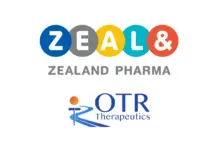UCB announced positive topline results from C-AXSPAND, a Phase 3 placebo controlled study to investigate the efficacy of CIMZIA® (certolizumab pegol) on the signs and symptoms of active axSpA in patients without x-ray evidence of ankylosing spondylitis (AS).
The study met the primary objective of achieving a major improvement, or ASDAS-MI, defined as a two-point improvement on the ASDAS at week 52 for CIMZIA-treated patients compared to placebo.3 The study also met Assessment of SpondyloArthritis International Society 40% (ASAS40) response at week 12, a key secondary objective.4
“People living with nr-axSpA frequently face delayed or incorrect diagnosis, and currently, in the US, there are no FDA approved options to treat this condition. The C-AXSPAND study results provide important insights into the potential of CIMZIA as an effective and durable treatment option for these patients. Additionally, the study is unique in that it used ASDAS-MI, a rigorous response threshold, and assessed the long-term efficacy of CIMZIA in a one-year, placebo-controlled trial.
The study included nr-axSpA patients with objective signs of inflammation, an extended placebo phase, and allowed for modification of background medications to help gain a deeper understanding of the natural history of axSpA and to demonstrate the need for biologic treatment for this disease,” said Atul Deodhar, MD, MRCP, FACP, FACR, Professor of Medicine, OHSU, and a lead investigator for the study.
“Axial spondyloarthritis is a painful, chronic inflammatory disease that starts in the sacroiliac joints and progresses to the spine, ultimately causing spinal fusion over time in many patients. People with nr-axSpA face a significant disease burden, similar to people with ankylosing spondylitis, and are in need of effective treatment options. The positive topline results of the C-XSPAND study show the significant value that CIMZIA may provide to people living with nr-axSpA.
The study also reinforces UCB’s leadership in this disease area and our commitment to connecting science to unmet patient needs and ultimately providing valuable solutions. We look forward to quickly submitting this data to the FDA for review,” said Emmanuel Caeymaex, Head of Immunology and Executive Vice President at UCB.
Axial Spondyloarthritis, or axSpA, is a spectrum of disease which comprises both non-radiographic axSpA and radiographic axSpA, also known as ankylosing spondylitis (AS). nr-axSpA and AS share similar symptomology and burden of disease. However, in AS there is a definitive structural change of the sacroiliac joints detectable by x-ray; while in nr-axSpA there is no definitive radiographic sacroiliitis, though there may be MRI evidence of sacroiliitis.5
The primary efficacy variable assessed in C-AXSPAND was ASDAS-MI response at Week 52.
The ASDAS is a composite index to assess patient disease activity. It is comprised of objective evidence of systemic inflammation, such as C-reactive protein, and patient-reported outcomes, such as back pain, duration of morning stiffness, patient global assessment of the disease, and peripheral pain/swelling. The ASDAS is a validated, highly discriminatory instrument for assessing disease activity in axSpA.
In the C-AXSPAND study, the primary outcome was defined as a composite endpoint that was achieved if a patient remained on study treatment through 52 weeks and achieved ASDAS-MI response at week 52.7 Patients in both the treatment and placebo groups remained on their background therapy for the duration of the study. No new safety signals were observed in the study.8
CIMZIA is approved by the FDA for adults with active AS, but not for nr-axSpA.
About Axial Spondyloarthrits (axSpA)
axSpA is a chronic inflammatory disease that typically starts in patients under 45 years of age, normally in their late teens and twenties. These relatively young patients face a significant disease burden whether they have AS (i.e., definitive evidence of sacroiliitis on x-ray) or nr-axSpA (i.e., no definitive evidence of sacroiliitis on x-ray). They often experience substantial back pain, prolonged and severe stiffness, sleep disturbances, reduced mobility and overall function, impaired quality of life, and impaired work and home productivity and social participation.9
Limited evidence exists regarding the exact prevalence of axSpA, though it is thought to impact a substantial proportion of the population. Recent data suggest that 0.5% to 1.4% of the adult population have axSpA, similar to the prevalence of rheumatoid arthritis, which is 0.5% to 1.0%.10,11,12
About C-AXSPAND13
C-AXSPAND is a multi-center, randomized, double-blind, parallel-group, placebo controlled study of certolizumab pegol (CZP) compared to placebo. The study randomized 317 adult patients with active axSpA without x-ray evidence of ankylosing spondylitis (AS). Patients needed to have evidence of inflammatory disease, defined as sacroiliitis on magnetic resonance imaging (MRI) and/or elevated C-reactive protein (CRP) levels. Patients must have had an inadequate response to, have a contraindication to, or have been intolerant to at least two non-steroidal anti-inflammatory drugs (NSAIDs). Inadequate response to an NSAID is defined as lack of response to at least 14 days of continuous NSAID therapy at the highest tolerated dose of the administered NSAID.
Patients whose disease activity could not be controlled by study medication and changes in background therapy (including but not limited to analgesics, NSAIDs, and slow-acting antirheumatic drugs) were permitted to withdraw from the study. Patients could either transition to open-label CZP treatment offered by UCB or to other treatment, including biologics, at the discretion of the investigator until the end of the trial.
The study includes a 52-week treatment period, an ongoing 2-year safety follow up extension, and an 8-week follow-up period after treatment is stopped. During the 52-week treatment period, patients received either placebo or a 400mg dose of CZP subcutaneously at weeks zero, two, and four, followed by 200mg of CZP every two weeks starting at week six.
The primary objective assessed in C-AXSPAND was the efficacy of CZP on the signs and symptoms of active axSpA in patients without x-ray evidence of AS. The primary efficacy variable assessed was ASDAS-MI response at Week 52.
The secondary objectives of the study were to assess efficacy, safety, and tolerability, and to demonstrate the effect of CZP on health outcomes, disease activity, sacroiliac (SI) joint inflammation through MRI, and changes in concomitant and background medications.
The key secondary efficacy variables at weeks 12 and 52 included ASAS40 response, change from baseline in Bath Ankylosing Spondylitis Functional Index (BASFI), change from baseline in Bath Ankylosing Spondylitis Disease Activity Index (BASDAI), change from Baseline in SI joint Spondyloarthritis Research Consortium of Canada (SPARCC) score (week 12 only), and the number of patients without relevant changes to background medication. Additional variables assessed at week 52 only were change from baseline in Ankylosing Spondylitis Quality of Life (ASQoL), the number of patients with anterior uveitis (AU) or new AU flares, and change from baseline in total and nocturnal spinal pain.
Safety variables assessed in the study were adverse events, vital signs, physical examination, and measurements of laboratory parameters.
About CIMZIA® in the US
CIMZIA® is the only Fc-free, PEGylated anti-TNF (Tumor Necrosis Factor). CIMZIA® has a high affinity for human TNF-alpha, selectively neutralizing the pathophysiological effects of TNF-alpha.
CIMZIA® is indicated for the treatment of adults with moderately to severely active rheumatoid arthritis, adults with active psoriatic arthritis (PsA), and adults with active ankylosing spondylitis (AS).
In addition, it is indicated for reducing signs and symptoms of Crohn’s disease and maintaining clinical response in adult patients with moderately to severely active disease who have had an inadequate response to conventional therapy. See important safety information including risk of serious bacterial, viral and fungal infections and tuberculosis below.
About UCB
UCB, Brussels, Belgium (www.ucb.com) is a global biopharmaceutical company focused on the discovery and development of innovative medicines and solutions to transform the lives of people living with severe diseases in immunology or neurology. With more than 7 500 people in approximately 40 countries, the company generated revenue of € 4.5 billion in 2017.




























